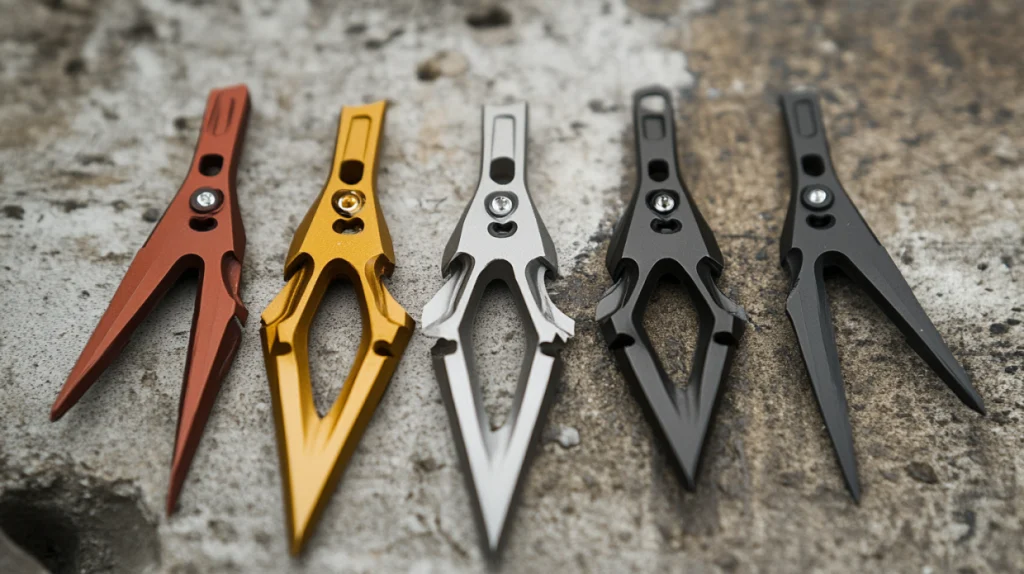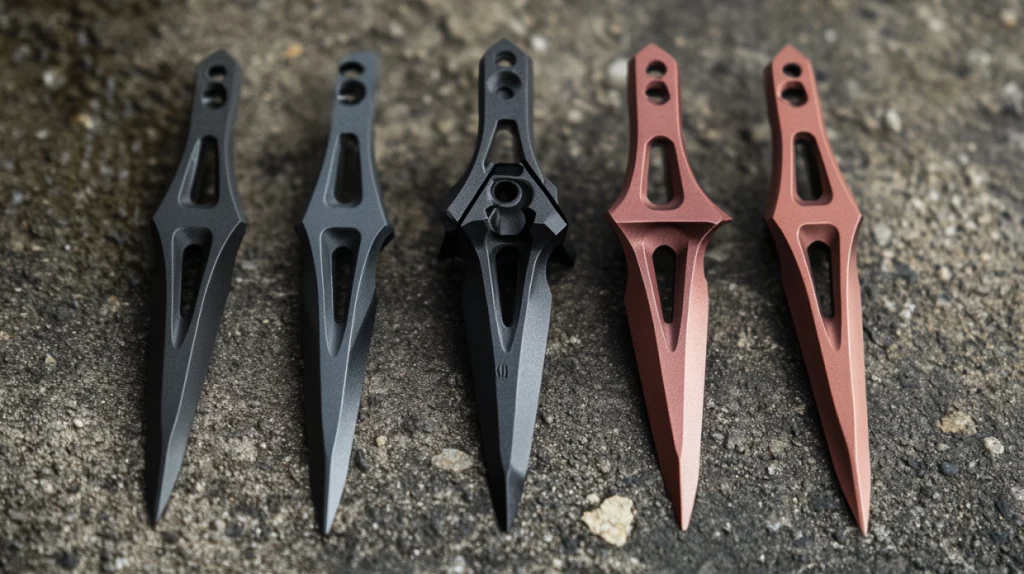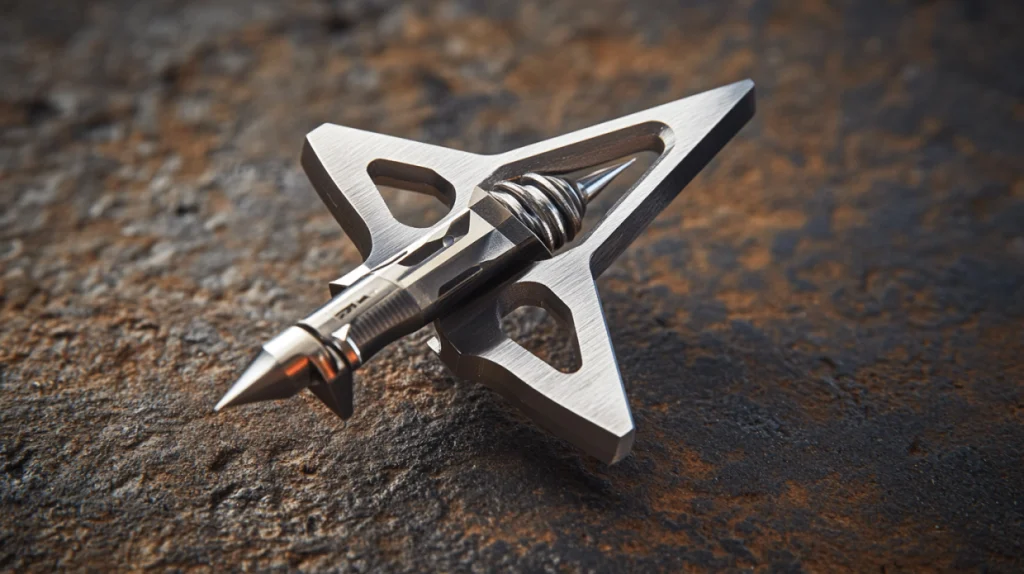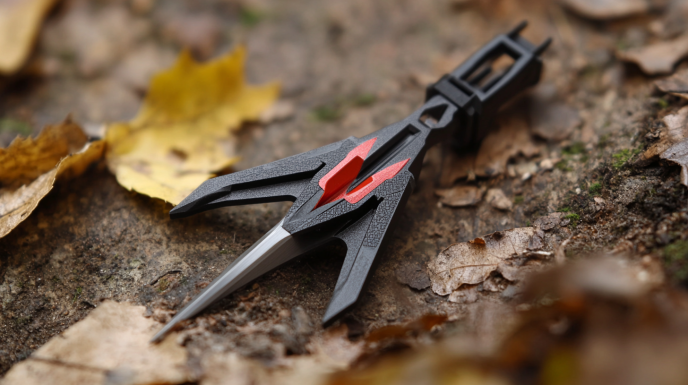
Rage Hypodermic Crossbow NC 2-Blade Broadhead, 100 Grain, 3-Pack, .035″ Stainless Steel Blades, R38200-3W
- 2-Blade Crossbow Broadhead
- 100 Grain
- Hybrid Hypodermic Tip
- Machined Stainless Steel Ferrule
- .035″ Blades
- 2″ Cutting Diameter
- No Collar Blade Lock
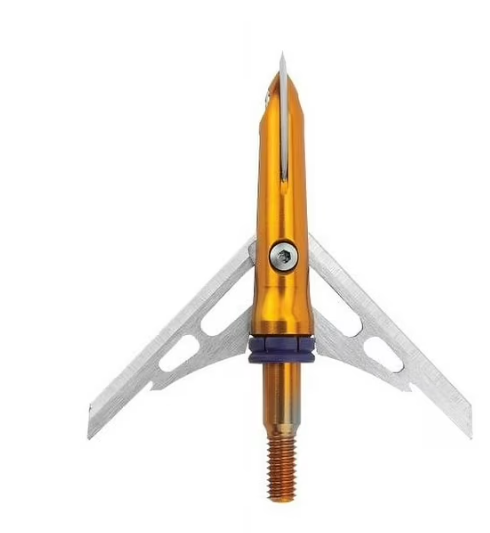
Rage CrossbowX 2-Blade 2″ 125 Grain Mechanical Broadhead (3-Pack) – R54000
- Rage Crossbow X Broadheads feature HexFlat design with no rubber bands. Reliable rear cam deployment. Flies like a field point. Machined aircraft-grade aluminum body. 2″+ cutting diameter. Shock collar for proper blade retention. F.A.T. (Ferrule Alignment Technology). Tough .035″ stainless blades.
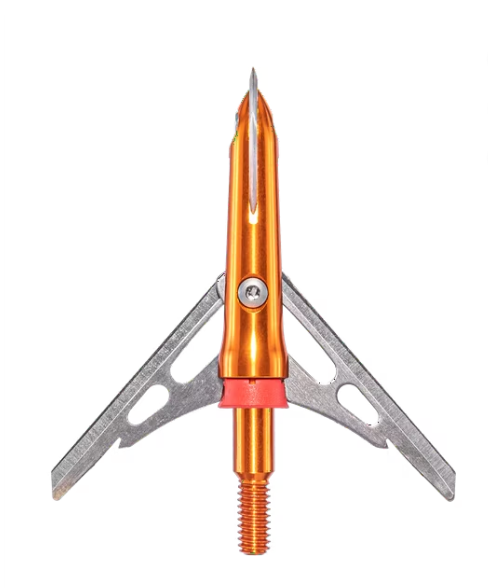
Rage Crossbow x Broadheads, SlipCam Rear Deploying, 2-Blade, 100 Grain, .035″ Stainless Steel Blades, R53000-3W
- 2-Blade Design
- Massive Leading Edge Tip Blade For Extreme Penetration
- Streamlined 3/4″ In Flight Diameter
- Slip Cam Rear Deploying Broadheads
- Aerodynamic Ferrule Designed For Peak Performance
- Cut-on-contact tip
- 2+ Inch Cutting Diameter
- 3 Per Pack
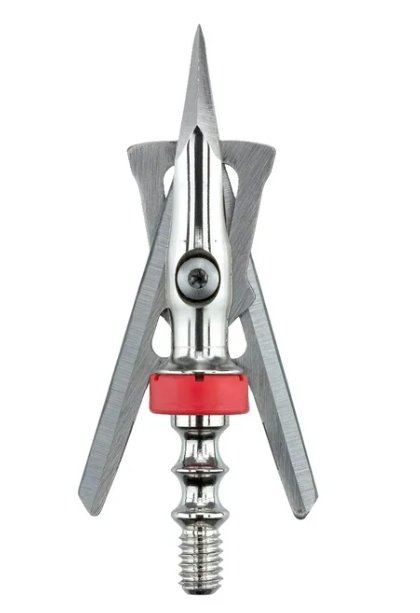
Rage Hypodermic Crossbow Broadhead, 2″ Cut
- The Rage Hypodermic Crossbow Broadhead 100 has a stainless steel hypodermic ferrule, weighs 100 grains, and has a 2″ cutting diameter
- With a stout blade thickness of 0.035, this broadhead is very strong and durable
- The high energy shock collar ensures proper deployment of the blades with all crossbows
How these razor-sharp game-changers are revolutionizing the modern hunting experience
In the crisp dawn air of early November, I watched my brother-in-law track a magnificent 10-point buck through our trail cameras for weeks. When the perfect moment finally arrived, his crossbow released with a subtle thwip. The bolt, tipped with a Rage Hypodermic Crossbow broadhead, disappeared into the morning mist. Moments later, we found a blood trail so substantial it looked like someone had spilled a bucket of paint across the forest floor. The buck had traveled less than 50 yards before collapsing. Such is the devastating efficiency of properly selected Rage Crossbow broadheads—they deliver what every ethical hunter demands: quick, humane kills with maximum blood trails for recovery.
This experience wasn’t mere luck. It was engineering precision meeting hunting expertise. Let me take you deep into the world of these remarkable hunting tools that have transformed the crossbow hunting landscape.
The Rage Revolution: Understanding the Broadhead Basics
Before diving into specifics, let’s establish what makes Rage broadheads special. Launched in 2006, Rage quickly disrupted the broadhead market with their innovative mechanical designs. Unlike traditional fixed-blade broadheads, Rage’s mechanical broadheads feature deployable blades that remain closed during flight and explosively open upon impact, creating massive wound channels that would make a trauma surgeon wince.
For crossbow hunters specifically, this design solves several persistent problems: improved aerodynamics in flight, field-point accuracy, and devastating terminal performance. But not all Rage broadheads are created equal, and selecting the perfect match for your hunting scenario requires understanding the available options.
Flagship Models: The Rage Crossbow Arsenal
The Rage lineup for crossbow hunters has expanded significantly over the years, with each model addressing specific hunting needs:
Rage Hypodermic Crossbow
Perhaps the most popular in their lineup, the Hypodermic features a needle-like point with a solid steel tip that punches through hide and bone like they’re made of paper. The streamlined profile allows these broadheads to fly true even from today’s high-speed crossbows pushing 400+ FPS.
The standard Hypodermic offers a 2-inch cutting diameter—substantial enough to create massive wound channels on deer-sized game without sacrificing penetration. For those hunting larger game like elk or moose, the Hypodermic +P variant provides enhanced penetration with a slightly reduced 1.5-inch cutting diameter.
Rage Trypan Crossbow
The Trypan represents Rage’s premium offering, featuring their proprietary “Trypan” tip design—a machined steel trocar tip with an incredible ability to punch through tough hide and bone. What separates this model is the legendary 2.2-inch cutting diameter that creates wound channels you could practically fit your fist through.
I’ve seen the aftermath of a perfect Trypan shot—the internal hemorrhaging is so extensive that animals typically expire within seconds rather than minutes. This is the broadhead for hunters who prioritize stopping power above all else.
Rage Slipcam Crossbow
A more recent addition to the Rage family, the Slipcam uses a unique cam-action deployment system rather than the traditional SlipCam mechanism. This innovation allows for more reliable blade deployment even at extreme angles or when hitting tougher material like shoulder blades.
With a 1.75-inch cutting diameter, the Slipcam balances penetration and cutting surface beautifully. This has become my go-to broadhead for whitetail hunting in areas with dense brush where deflection concerns are real.
Rage X-Treme Crossbow
For those seeking maximum blood trails, the X-Treme delivers with its massive 2.3-inch cutting diameter—the largest in Rage’s crossbow-specific lineup. While this reduced surface area can theoretically reduce penetration, the razor-sharp .035-inch stainless steel blades slice through tissue with minimal resistance.
The X-Treme excels in open-country hunting scenarios where you might need to track game across longer distances. The blood trails these broadheads create are so substantial that even novice hunters can follow them.
Where to Purchase Quality Rage Crossbow Broadheads
Finding authentic Rage broadheads is easier than ever, but beware of counterfeits. Always purchase from authorized retailers to ensure you’re getting genuine Rage products with full factory warranties. Top options include:
- Bass Pro Shops/Cabela’s: Extensive selection with knowledgeable staff
- Scheels: Competitive pricing and frequent sales
- Local archery pro shops: Expert advice and potential for package deals
- Direct from Feradyne Outdoors (Rage’s parent company)
- Online retailers like Lancaster Archery Supply or 3Rivers Archery
Expect to pay between $40-65 for a pack of three broadheads, depending on the model and retailer. While this might seem expensive compared to some fixed-blade options, consider it an investment in both accuracy and ethical harvesting. One clean kill is worth a dozen missed opportunities.
The Cost Factor: Investment vs. Value
The pricing structure for Rage broadheads reflects their position as premium hunting tools:
- Entry-level options (Rage Crossbow X): $39.99 for 3-pack
- Mid-range options (Hypodermic Standard): $49.99 for 3-pack
- Premium offerings (Trypan, Hypodermic NC): $54.99-64.99 for 3-pack
While this represents a significant investment compared to basic fixed-blade broadheads that might cost $25-30 per pack, the performance difference is substantial. Additionally, replacement blade kits (typically $19.99-24.99) allow you to refurbish your broadheads after successful hunts, extending their usable life considerably.
My personal approach has been to maintain 6-9 broadheads in my hunting kit: three for practice, three primary hunting heads, and three backups. This rotation allows me to ensure my primary heads remain razor-sharp and perfectly tuned for when it matters most.
Mechanical vs. Fixed: The Eternal Debate
The broadhead debate between mechanical and fixed designs has raged (pun intended) for decades among serious bowhunters. For crossbow hunters specifically, the advantages of mechanicals like Rage have become increasingly clear:
Mechanical Advantages:
- Superior flight characteristics that match field points
- Larger cutting diameters without sacrificing flight stability
- Reduced planing effect during flight
- Better performance from modern high-speed crossbows
- Devastating wound channels for improved blood trails
Fixed-Blade Considerations:
- No moving parts to potentially fail
- Generally better penetration on larger game
- More durable for pass-through shots hitting soil or trees
- Typically less expensive
- Legal in all hunting jurisdictions (some areas restrict mechanicals)
For crossbow hunters specifically, the flight advantages of mechanicals typically outweigh the potential disadvantages. Modern crossbows generate tremendous kinetic energy—often 30-40% more than compound bows—which mitigates penetration concerns when using properly designed mechanical broadheads.
Installing and Tuning Rage Broadheads for Maximum Performance
Proper installation is critical for optimal performance. Here’s my proven process:
- Use the included practice head first. Most Rage packages include a practice head that mimics the flight characteristics without deployable blades. Use this to verify your crossbow’s accuracy before switching to the actual hunting heads.
- Ensure proper alignment. Thread the broadhead onto your bolt and check for perfect alignment. Any wobble or runout will devastate accuracy.
- Set proper tension. Most Rage models include an O-ring retention system or ShockLock. Ensure these are correctly installed according to the package instructions.
- Verify weight. Use a grain scale to confirm your broadheads match the labeled weight (typically 100 or 125 grains). Minor variations can affect trajectory.
- Test flight. After installation, fire several bolts at your target from hunting distances (typically 20-40 yards) to verify point of impact matches your field points.
A common mistake is overtightening the broadhead on the bolt. Use gentle pressure with broadhead wrenches rather than excessive force that could damage the threads or ferrule.
Crossbow Compatibility Considerations
While Rage broadheads work with most modern crossbows, certain factors affect compatibility:
Speed Limitations
Most Rage models are rated for crossbows shooting up to 400 FPS. For faster crossbows (some modern models reach 440+ FPS), look specifically for “NC” (No Collar) variants designed to handle extreme velocities without premature deployment.
Kinetic Energy Requirements
For reliable blade deployment and penetration, Rage recommends minimum kinetic energy values:
- Deer-sized game: 55+ ft-lbs
- Elk/moose-sized game: 70+ ft-lbs
- Large dangerous game: 90+ ft-lbs
Most modern crossbows easily exceed these values, but older or youth-oriented models might fall short. Calculate your crossbow’s kinetic energy using this formula:
KE = (bolt weight in grains × velocity in fps²) ÷ 450,240
Rail/Barrel Clearance
Some compact crossbows with narrow rails might experience clearance issues with certain broadhead designs. This is rarely a problem with Rage due to their closed-in-flight profile, but always verify clearance before hunting.
Field Performance: Real-World Effectiveness on Game
The ultimate test of any broadhead comes in the field. After personally taking dozens of deer with various Rage models and interviewing countless fellow hunters, certain patterns emerge:
On Whitetail Deer
Rage broadheads excel on medium-sized game like whitetail deer. The combination of cutting diameter and penetration creates devastating wounds that typically result in recovery distances under 100 yards. The massive blood trails produced by Rage broadheads make tracking straightforward even in challenging conditions like rain or darkness.
The Hypodermic and Trypan models particularly shine here, with the 2-2.2 inch cutting diameters creating hemorrhaging that quickly drops blood pressure and leads to rapid expiration.
On Larger Game
For elk, moose, or large hogs, penetration becomes more critical. The Hypodermic +P and Slipcam models provide the best balance of cutting diameter and penetration for these thick-skinned, heavy-boned animals.
A friend who exclusively hunts elk in Colorado switched to the Hypodermic +P after years of using fixed-blade broadheads. His report: “The penetration is nearly identical, but the blood trails are incomparable. I’m finding bulls in half the time with half the stress.”
On Turkey
For turkey hunters, the standard Hypodermic provides more than enough cutting diameter while minimizing the chance of complete pass-through that might result in lost birds. The devastating initial impact typically anchors birds on the spot.
Weight Options and Their Impact on Performance
Rage offers their crossbow broadheads in two primary weight classes:
100-Grain Models
The standard weight for most hunting setups, 100-grain broadheads maintain higher speeds and flatter trajectories. These are ideal for hunting scenarios under 40 yards where trajectory is critical.
125-Grain Models
The heavier option provides approximately 15-20% more kinetic energy and forward-of-center (FOC) balance for improved penetration. These excel for larger game or when maximum penetration is required.
Some bowhunters mistakenly believe heavier always means better penetration, but this oversimplifies complex terminal ballistics. The optimal choice depends on your crossbow’s specs, hunting distances, and target game.
Competitive Landscape: How Rage Compares to Competitors
The premium mechanical broadhead market features several strong competitors:
Rage vs. Grim Reaper
Grim Reaper’s Whitetail Special and Carni-Four models offer similar performance to Rage but with different deployment mechanisms. Grim Reapers typically feature a spring-tension system rather than Rage’s SlipCam. In field testing, Rage broadheads generally create larger entrance wounds while Grim Reapers sometimes produce more substantial exit wounds.
Rage vs. Muzzy
Muzzy’s Trocar HB hybrid broadheads combine fixed and mechanical designs for redundancy. While innovative, they typically don’t match the flight characteristics or wound channels of dedicated mechanical broadheads like Rage. Where Muzzy excels is durability and reliability in extreme conditions.
Rage vs. Sevr
Sevr’s premium locked-blade broadheads offer exceptional blade retention but at a significantly higher price point than Rage. The rear-deploying blade design creates different wound patterns that some hunters prefer, particularly on quartering shots.
In terms of market share and proven field performance, Rage continues to dominate the mechanical broadhead category through consistent innovation and reliability.
High-Speed Compatibility: Performance at Extreme Velocities
Modern crossbows routinely achieve speeds exceeding 400 FPS, creating unique challenges for broadhead performance. At these velocities, many mechanical broadheads risk premature deployment or structural failure.
Rage addressed this with their NC (No Collar) technology, replacing the traditional O-ring retention system with an internal mechanism that prevents premature deployment even at extreme speeds. Models featuring this technology include:
- Hypodermic NC
- Trypan NC
- Slipcam NC
These variants typically cost $5-10 more per pack but provide peace of mind for hunters using cutting-edge crossbow technology. For crossbows under 380 FPS, standard Rage models perform excellently without the NC upgrade.
Replacement Blades and Maintenance
One of Rage’s strongest selling points is their fully replaceable blade system. After a successful harvest, hunters can:
- Remove damaged or dulled blades using the provided tools
- Clean the ferrule and internal components with warm water and mild soap
- Install fresh, factory-sharpened replacement blades
- Replace O-rings or shock collars as needed
Replacement blade kits cost $19.99-24.99 depending on the model, making each broadhead refurbishment about $7 versus buying new broadheads at $16-20 each. Over a hunting career, this represents substantial savings.
Pro tip: Always carry a blade replacement kit in your hunting pack. Nothing is more frustrating than damaging your only broadheads before prime hunting hours.
Material Science: What Makes Rage Broadheads Tick
The engineering behind Rage broadheads involves sophisticated materials science:
Ferrule Construction
Most Rage models use aircraft-grade aluminum for the ferrule (body), providing an excellent strength-to-weight ratio. Premium models like the Trypan feature one-piece machined steel ferrules for maximum structural integrity.
Blade Materials
The cutting blades utilize .035″ thick stainless steel, precision-ground to surgical sharpness. This thickness represents a carefully calculated balance between cutting efficiency and structural integrity.
Retention Systems
The original SlipCam system uses medical-grade O-rings that maintain consistent tension regardless of temperature fluctuations. The newer ShockLock system eliminates O-rings entirely for improved reliability in extreme conditions.
Ensuring Accuracy with Rage Broadheads
Achieving field-point accuracy with broadheads requires attention to several factors:
Proper Bolt Selection
Match your broadhead weight to your bolt weight for optimal Front-of-Center (FOC) balance. For 100-grain broadheads, bolts in the 400-425 grain total weight range typically perform best.
Fletching Considerations
For mechanical broadheads, 3-4″ vanes provide sufficient stabilization without excessive drag. Some crossbow hunters find that slightly offset fletching rather than extreme helical improves accuracy with mechanical broadheads.
Practice Strategies
Limit actual broadhead practice to confirm zero rather than extensive target practice to preserve edge sharpness. The included practice head allows for unlimited practice with identical flight characteristics.
Tuning for Precision
If broadheads aren’t grouping with field points, consider these adjustments:
- Verify nock rotation for consistent alignment
- Check for proper barrel/rail clearance
- Confirm broadhead alignment and tightness
- Use precision nocking points for consistent loading
Model Variations and Specialized Options
Beyond the flagship models, Rage offers specialized broadheads for specific hunting scenarios:
Rage Crossbow X
The budget-friendly option in the lineup offers a 2″ cutting diameter with slightly simpler construction than the Hypodermic. This model provides excellent value for hunters on a budget without sacrificing the core Rage technology.
Hypodermic Trypan NC
The premium offering combines the Trypan’s 2.2″ cutting diameter with the NC technology for maximum performance from ultra-fast crossbows. While expensive ($64.99/3-pack), they represent the pinnacle of mechanical broadhead technology.
Rage Chisel Tip
For hunters encountering heavy bone or tough hide, the Chisel Tip variant replaces the standard cut-on-contact tip with a bone-crushing chisel point designed to punch through shoulder blades and heavy ribs.
Legal Considerations for Broadhead Use
Before selecting any broadhead, understand your local hunting regulations:
- Cutting diameter restrictions: Some states limit maximum cutting diameter (usually 7/8″ to 1″)
- Mechanical restrictions: A few jurisdictions still prohibit mechanical broadheads entirely
- Minimum weight requirements: Most states require broadheads to weigh at least 100 grains
- Special public land rules: Some managed areas have specific broadhead requirements
While most states have embraced mechanical broadhead technology, always verify current regulations before hunting.
Sharpening and Maintenance Practices
While replacement blades offer factory-fresh sharpness, proper maintenance extends blade life:
Field Sharpening
For touch-ups in the field, diamond sharpening cards work well on stainless steel Rage blades. Maintain the factory angle (approximately 22-25 degrees) with consistent pressure.
Deep Cleaning
After exposure to blood or tissue, disassemble completely and soak components in hydrogen peroxide to remove protein residue before lubricating moving parts with a drop of mineral oil.
Storage Considerations
Store broadheads in their original packaging or dedicated broadhead cases with blades in the closed position to prevent accidental deployment and maintain O-ring tension.
Game-Specific Recommendations
Different hunting scenarios call for specific broadhead selections:
For Whitetail Deer
The standard Hypodermic or Trypan provides the optimal balance of penetration and wound channel for deer-sized game. The 2″-2.2″ cutting diameter creates massive hemorrhaging while still allowing complete pass-through on most shot angles.
For Elk/Moose
The Hypodermic +P or Slipcam offers enhanced penetration needed for larger game. The slightly reduced cutting diameter (1.5″-1.75″) focuses kinetic energy for deeper penetration through thick hide and heavy bone.
For Hogs
The Chisel Tip variant excels on tough-skinned, heavily-shielded wild hogs. The bone-crushing tip helps ensure penetration of the notoriously tough shoulder plates while still deploying the devastating expandable blades.
For Turkey
Any standard Rage model works exceptionally well, with many hunters preferring the original Rage 2-blade for its reliability and massive cutting surface when targeting the thin-skinned, vital-rich body of wild turkeys.
Conclusion: The Rage Advantage
After spending countless hours in the field with various broadheads across two decades of bowhunting, I’ve come to a simple conclusion: Rage Crossbow broadheads represent the optimal balance of accuracy, lethality, and reliability for the modern crossbow hunter. Their continued innovation, responsive design improvements, and proven field performance justify their premium price point.
Whether you’re pursuing whitetails in the hardwoods, elk in the mountains, or hogs in the swamp, there’s a Rage broadhead engineered specifically for your needs. The confidence that comes from knowing your broadhead will fly true and create devastating wound channels is something every ethical hunter values above all else.
Remember: The best broadhead is the one that helps you make quick, humane kills with easily followed blood trails. In that critical category, Rage continues to set the standard by which all others are measured.

